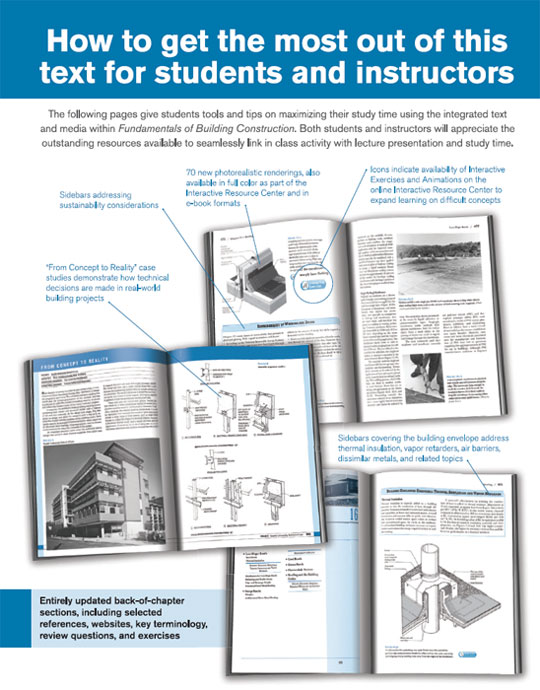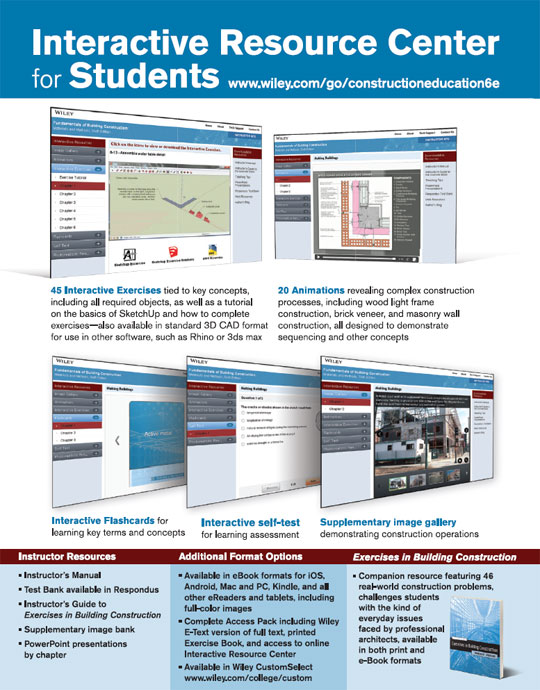PREFACE TO THE SIXTH EDITION
First published a quarter-century ago, Fundamentals of Building Construction: Materials and Methods, now in its sixth edition, has wrought a revolution in construction education. It has been instrumental in making a previously unpopular area of study not merely palatable but vibrant and well liked. It has taken a body of knowledge once characterized as antithetical to design excellence and made it widely recognized as being centrally relevant to good building design. It has replaced dry, unattractive books with a well-designed, readable volume that students value and keep as a reference work. It was the first book in its field to be even-handed in its coverage and profusely and effectively illustrated throughout. It was the first to release the teacher from the burden of explaining everything in the subject, thereby freeing class time for discussions, case studies, field trips, and other enrichments.
Gaining a useful knowledge of the materials and methods of building construction is crucial and a necessity for the student of architecture, engineering, or construction, but it can be a daunting task. The field is huge, diverse, and complex, and it changes at such a rate that it seems impossible ever to master it. This book has gained its preeminent status as an academic text in this field because of its logical organization, outstanding illustrations, clear writing, pleasing page layouts, and distinctive philosophy.
It is integrative, presenting a single narrative that interweaves issues of building science, materials science, legal constraints, and building craft so that the reader does not have to refer to separate parts of the book to make the connections among these issues. Building techniques are presented as whole working systems rather than component parts.
It is selective rather than comprehensive. This makes it easy and pleasant for the reader to gain a basic working knowledge that can later be expanded, without piling on so many facts and figures that the reader becomes confused or frightened away from wanting to learn about construction. Reading other texts was once like trying to drink from a fire hose; reading this one is like enjoying a carefully prepared meal.
It is empowering because it is structured around the process of designing and constructing buildings. The student of architecture will find that it features the design possibilities of the various materials and systems. Students interested in building or managing the construction process will find its organization around construction sequences to be invaluable.
The book is necessarily complex without being complicated. It avoids the dilemma of having to expand ad infinitum over time by presenting the basic construction systems, each in sufficient detail that the student is brought to an operational level of knowledge. It deals, as its subtitle indicates, with fundamentals.
In this latest edition, we have updated and revised many portions of the text. To name a few, in Chapter 1, an expanded discussion of buildings and the environment reflects the continuing evolution and maturation of sustainable building practice. Attention to the role of the constructor and to considerations of construction management continues to receive more in-depth consideration. Many facets of foundations and sitework have been updated in Chapter 2. Chapters 3 through 7, covering wood materials and construction systems, have been extensively updated: An entirely new construction system, cross-laminated timber, is introduced; a greater emphasis is given to manufactured wood products, reflecting this trend within the industry; and the influence of the most recent energy codes and sustainability standards on the enclosure of these building systems is reflected in revised text and updated illustrations. Throughout the remaining portions of the text, new developments in materials and methods, sustainable practices, and building regulations have been incorporated. Finally, a special effort was made to update illustrations and photographs, both to ensure currency of information and to provide the greatest possible visual interest for the reader.
We continue to take maximum advantage of the World Wide Web. The text's encyclopedic details, along with an array of additional resources for both students and instructors, are readily available via its dedicated web site (www.wiley.com/go/constructioneducation6e). A Respondus test bank, PowerPoint lecture slides, Instructor's Manual, and more can be found there for instructors. For students, there are flashcards and interactive self-test questions, as well as SketchUp exercises and animations, which are indicated by icons found throughout the text. Coauthor Joseph Iano's construction blog (www.ianosbackfill.com) provides an outlet for additional content and coverage of new developments in the field. The selected list of Web site addresses included in the reference section at the end of each chapter provides links to the other most relevant resources that are available on the Web, which provide starting points for students' further explorations.
The updated companion Exercises in Building Construction and its answer key continue to provide a unique and invaluable tool for helping students to understand the real-world application of building construction knowledge to the design and construction of buildings.
In this edition, a special thank-you goes to illustrators Heather McArthur and Terrel Broiles for their patience with the authors, perseverance in their work, and success in maintaining the high standards established by this book's previous illustrators. Alexander Schreyer also deserves mention for his contribution of interactive exercises and other supporting materials on the companion Web site.
The authors are, as always, grateful to the publisher, John Wiley & Sons, without whom the continued improvement of this text and its supporting materials would not be possible. Amanda L. Miller, Vice President and Publisher, has for many years been a source of wisdom and support. Paul Drougas, Editor, has been invaluable for his industry knowledge, patience, and sense of humor. He remains a true friend. Lauren Olesky, Developmental Editor, and Mike New, Editorial Assistant, have been hard working and helpful through all stages of this revision. Donna Conte, Senior Production Editor, continues, as in previous revisions, to oversee the most difficult task of managing production and schedules with grace and perseverance. Diana Cisek, and too many others to name here, also deserve our thanks for their parts in helping bring this effort to fruition.
We especially offer our thanks to the many teachers, students, and professionals who have purchased and used this work. Your satisfaction is our greatest reward, your loyalty is greatly appreciated, and your comments are always welcome!
—E.A., South Natick, Massachusetts
—J.I., Seattle, Washington
A registration code to access the resources included on the
Interactive Resource Center, shown on the previous page,
is included with each new print copy of
Fundamentals of Building Construction, Sixth Edition.
If you've purchased another version and wish to purchase
access to the Interactive Resource Center, you can go to
www.wiley.com/go/constructioneducation6e,
click on “Student Companion Site” and then “Register,”
which will allow you to enter a code or to purchase access
if you do not have a code.

